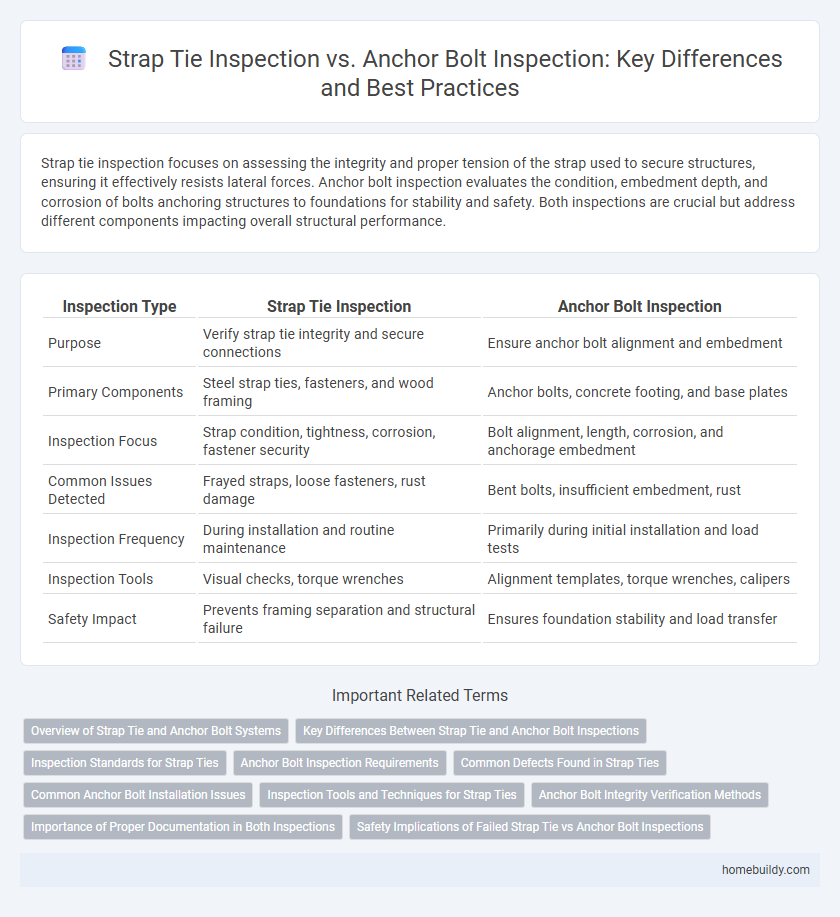Strap tie inspection focuses on assessing the integrity and proper tension of the strap used to secure structures, ensuring it effectively resists lateral forces. Anchor bolt inspection evaluates the condition, embedment depth, and corrosion of bolts anchoring structures to foundations for stability and safety. Both inspections are crucial but address different components impacting overall structural performance.
Table of Comparison
| Inspection Type | Strap Tie Inspection | Anchor Bolt Inspection |
|---|---|---|
| Purpose | Verify strap tie integrity and secure connections | Ensure anchor bolt alignment and embedment |
| Primary Components | Steel strap ties, fasteners, and wood framing | Anchor bolts, concrete footing, and base plates |
| Inspection Focus | Strap condition, tightness, corrosion, fastener security | Bolt alignment, length, corrosion, and anchorage embedment |
| Common Issues Detected | Frayed straps, loose fasteners, rust damage | Bent bolts, insufficient embedment, rust |
| Inspection Frequency | During installation and routine maintenance | Primarily during initial installation and load tests |
| Inspection Tools | Visual checks, torque wrenches | Alignment templates, torque wrenches, calipers |
| Safety Impact | Prevents framing separation and structural failure | Ensures foundation stability and load transfer |
Overview of Strap Tie and Anchor Bolt Systems
Strap tie systems provide lateral support by connecting structural elements and are typically made from galvanized steel or stainless steel for corrosion resistance. Anchor bolt systems secure structural components to concrete foundations, ensuring stability under tension and shear forces. Inspecting strap ties focuses on checking for corrosion, proper tension, and secure fastenings, while anchor bolt inspections prioritize assessing bolt embedment, integrity, and signs of cracking or loosening around the foundation.
Key Differences Between Strap Tie and Anchor Bolt Inspections
Strap tie inspections focus on verifying tension integrity, corrosion resistance, and secure connections to structural elements, while anchor bolt inspections emphasize bolt embedment depth, alignment, and load-bearing capacity. Strap tie inspections often involve checking for material degradation and correct installation to prevent lateral movement, whereas anchor bolt inspections prioritize structural anchorage and foundation stability. Understanding these key differences ensures targeted maintenance and safety compliance in construction frameworks.
Inspection Standards for Strap Ties
Strap tie inspection standards emphasize verifying proper tension, corrosion resistance, and secure fastening in compliance with ASTM F594 and AISC specifications, ensuring structural stability. Unlike anchor bolt inspection which focuses on embedment depth, alignment, and concrete integrity per ACI 318, strap tie evaluations prioritize visual and mechanical checks for deformation or damage. Regular inspections following industry standards help prevent joint failures by ensuring strap ties maintain required load-bearing capacity and durability.
Anchor Bolt Inspection Requirements
Anchor bolt inspection requires verifying proper embedment depth, torque specifications, and absence of corrosion to ensure structural stability. Inspectors must confirm correct alignment, thread condition, and use of washers or nuts per engineering standards. Regular anchor bolt inspections reduce risks of structural failure compared to strap tie inspections, which primarily focus on strap tension and connection integrity.
Common Defects Found in Strap Ties
Strap tie inspection frequently reveals common defects such as corrosion, improper alignment, and loose fasteners that compromise structural stability. Unlike anchor bolt inspection, which primarily focuses on bolt embedment depth and concrete integrity, strap tie examination emphasizes surface conditions and connection integrity. Detecting these defects early can prevent structural failures and enhance the lifespan of load-bearing systems.
Common Anchor Bolt Installation Issues
Strap tie inspection often highlights common anchor bolt installation issues such as improper embedment depth, misalignment, and inadequate torque, which compromise structural integrity. Ensuring accurate anchor bolt placement and securing methods prevents failure under load and maintains the effectiveness of strap tie connections. Regular inspections emphasize verifying bolt condition, corrosion levels, and alignment to reduce risks associated with faulty anchor bolt installations.
Inspection Tools and Techniques for Strap Ties
Strap tie inspection relies on visual examination, torque wrenches, and load cells to ensure proper tension and structural integrity, while anchor bolt inspection often employs ultrasonic testing and magnetic particle inspection for detecting internal flaws. The use of calibrated torque wrenches and tension meters is critical in strap tie assessments to verify the correct application of force and prevent loosening. Advanced imaging devices and nondestructive testing techniques enhance the reliability of strap tie inspections by identifying corrosion, cracking, or deformation without dismantling the structure.
Anchor Bolt Integrity Verification Methods
Anchor bolt integrity verification methods primarily involve non-destructive testing techniques such as ultrasonic testing, magnetic particle inspection, and torque testing to ensure the bolt's strength and proper embedment within concrete. Unlike strap tie inspection, which focuses on tension and corrosion resistance of the tie components, anchor bolt verification emphasizes assessing bolt elongation, thread condition, and concrete interface stability. Accurate anchor bolt inspection mitigates structural risks by confirming secure load transfer between steel frameworks and foundations.
Importance of Proper Documentation in Both Inspections
Proper documentation in strap tie inspection ensures accurate tracking of tension integrity and corrosion status, critical for structural stability. In anchor bolt inspection, detailed records of bolt placement, torque values, and damage detection provide essential data for safety assessments. Consistent documentation facilitates regulatory compliance and enables timely maintenance, preventing costly structural failures.
Safety Implications of Failed Strap Tie vs Anchor Bolt Inspections
Failed strap tie inspections pose significant safety risks, including structural instability and potential collapse due to compromised load distribution. In contrast, anchor bolt inspection failures primarily affect the secure anchorage of structures, increasing the likelihood of detachment under stress or seismic activity. Regular and thorough inspections of both strap ties and anchor bolts are critical to maintaining overall structural integrity and preventing catastrophic failures.
strap tie inspection vs anchor bolt inspection Infographic

 homebuildy.com
homebuildy.com